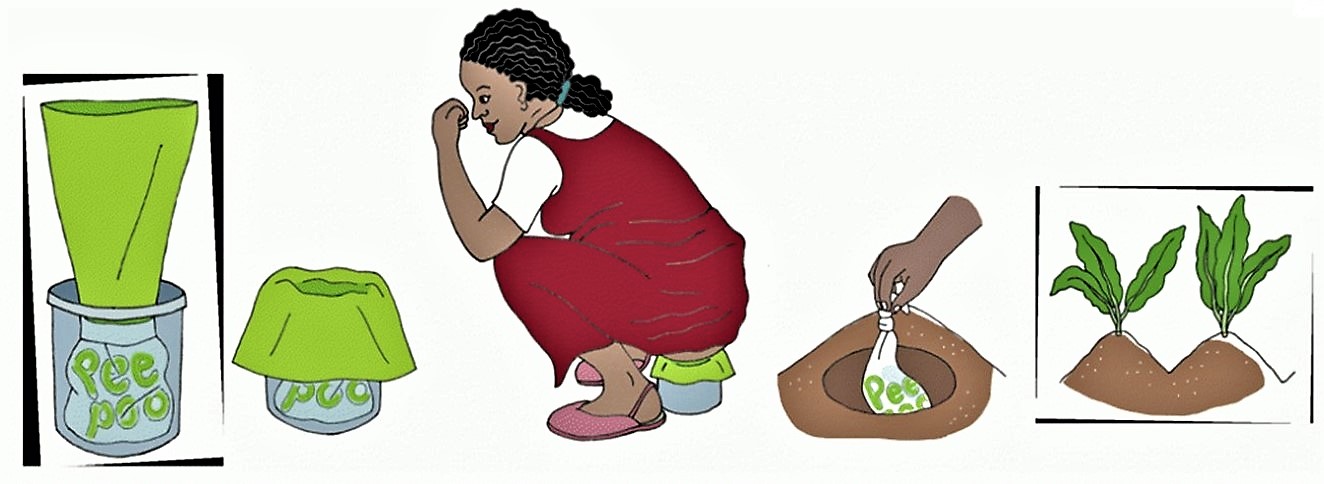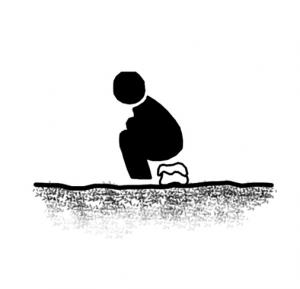Executive Summary
The Peepoo is a self-sanitising biodegradable personal single-use toilet. It is especially suitable for urban slum areas and in emergency relief where there is no space, where there are problems with high water tables and pits cannot be built, and places where water is scarce. The Peepoo can be used to collect both faeces and urine. It can be used standing or sitting, with just your hand or in a small bucket. The Peepoo contains urea, which sanitises the faeces from all dangerous bacteria, viruses and parasites. The Peepoo is odour free for up to 12 to 24h and can thus be stored without problem in people’s homes until it is convenient to hand in at a drop point. After it has been stored 2 to 4 weeks, at an average temperature of at least 20ºC, pathogens are inactivated and the content can be used as a safe fertiliser and soil amendment.
| In | Out |
|---|---|
Organic Solid Waste, Compost / Biosolids, Fertiliser |
Introduction
Flying toilets are a common problem in urban areas like slums. To provide access to safe and acceptable toilet system in urban areas with a dense and generally poor population, one has to face the challenges of the lack of availability of space, willingness to pay and the absence of an institutional infrastructure. The Peepoo toilet could be an alternative solution. It is a personal, biodegradable toilet for single-use. It can be used either sitting or standing, where and whenever the user wants and it is easy to carry around. After use it can be stored odour free up to 12 to 24h until it is handed over to the collection system and finally buried in the soil, where it serves as fertiliser.
Another option is for people in urban slums to use it in their home gardens, so called vertical gardens. The big advantage is that no fix infrastructure and thus no space and no investment costs are needed as it can be distributed very quickly and easily. However, in order to get the full value from the Peepoo solution, using it as a high value fertiliser for local farmers and other agriculture businesses, a logistical infrastructure is required for the collection of used Peepoos.This also helps in avoiding accumulation in people’s backyard. Moreover, no water is needed which makes this technology suitable for water scarce areas.
Basic Design and Treatment
The Peepoo is in the form of a slim and elongated bag (14 x 38 cm). Within the bag there is a thin inner-gauze (26 x 24 cm), and a filling of urea. When the urea comes into contact with faeces or urine, a breakdown into ammonia and carbonate takes place, driven by enzymes, which are naturally occurring in faeces. As the urea is broken down, the pH value of the material increases and hygienisation begins. Organisms, which produce diseases (pathogens) and may be found in faeces (bacteria, viruses and parasites) are inactivated within 2 to 4 weeks depending on the surrounding temperature. In the end, when the Peepoo degrades in the soil, the ammonia acts as a harmless fertiliser taken up by plants.

The Peepoo is designed to be used once, either sitting, squatting or standing. If one uses the Peepoo by holding it with only the hand, the thin inner gauze (green in the picture above) prevents all contact with the excrement. The Peepoo can also be placed in a cut plastic bottle or small bucket and used as a chamber pot. Peepoos are odour free for at least 24 hours after use and can thus be stored in the immediate environment.

Cost Consideration
Peepoo toilets are very low cost. In the beginning Peepoos were distributed for free in case studies, but since October 2010 the Peepoos are for sale in the urban slum of Kibera in the outskirts of Nairobi, Kenya. The average cost for Peepoo users in the urban slum is estimated to be about 10 USD per person per year. The calculation includes a drop point system where the users are refunded for handing in their used Peepoos, that later can be used as valuable fertilisers (Personal communication the Peepoople team 2011). This system requires that the market for Peepoo fertiliser has been developed and that there is an interest to run the collection points and pay the Peepoo users their refunds (see demand creation).
Compared to other toilets there are no installation costs: Peepoos require no large infrastructure solutions (except for collection points) and no pipes need to be built. Nor is there any need for any overhead system or investment costs. But in order to be an economically sustainable solution a logistic system is required that includes the Peepoo toilets distribution, collection and processing (market-based solution to cover Peepoo costs or managed by public service) (GTZ 2009).
Health Aspects
The Peepoo is hygienic: sealing the Peepoo after use cuts contact between excreta with land, water, insects, animals and people. Each Peepoo contains 4 g of urea, which work to rapidly destroy pathogens (including the hard to destroy helminth eggs). This so-called “ammonia-based” sanitation technology makes the excreta safe to use as fertiliser within a relatively short period of storage (2 to 4 weeks at an average temperature of at least 20ºC).
| Working Principle | The Peepoo is a self sanitising, biodegradable, personal single-use toilet. It is suitable for urban areas with water scarcity and emergencies. It can be used standing or sitting. The inside contains urea, which hygienises faeces and urine. The Peepoo is odour free for 12 to 24h and can be stored until it gets collected. After it has been stored 2 to 4 weeks at average temperatures of at least 20ºC pathogens are inactivated and the content can be used for soil amendment. |
| Capacity/Adequacy | No fix infrastructure and thus no space and no investment costs are needed as it can be distributed very quickly and easily. |
| Performance | Can be used everywhere. To be used as fertiliser it needs be stored for 2 to 4 weeks at average temperatures of at least 20ºC. |
| Costs | Low-Cost |
| Self-help Compatibility | The Peepoo is produced by the Peepoople company, but sold and distributed by local micro-entrepreneur sales women, who thus can earn their income from keeping the community clean and safe |
| O&M | No O & M required. But a logistical infrastructure is needed, so that used Peepoos do not accumulate in the backyard and the excreta can be used as fertiliser in agriculture.
|
| Reliability | High |
| Main strength | Low-cost; no water required; can be carried around and used at any time anywhere; no fix infrastructure and thus no space and no investment costs are needed as it can be distributed easily and quickly |
| Main weakness | Logistical infrastructure is needed to ensure that used Peepoos do not accumulate in the backyard and enabling the used Peepoos to be used as high value fertilisers in agriculture, adding to food security. |
The Peepoo toilet is particularly suitable in urban areas with place scarcity, water scarcity where there is a lack of sanitary infrastructure.
Results of a medium-scale trial of single-use, self-sanitising toilet bags in poor urban settlements in Bangladesh
This case study investigates whether toilet bags are a feasible sanitation alternative for poor urban settlements including the socio-cultural acceptance.
GTZ (2009): Results of a medium-scale trial of single-use, self-sanitising toilet bags in poor urban settlements in Bangladesh. Eschborn: German Agency for Technical Cooperation (GTZ) GmbH URL [Accessed: 12.05.2019]Use of the Peepoo
Results of a medium-scale trial of single-use, self-sanitising toilet bags in poor urban settlements in Bangladesh
This case study investigates whether toilet bags are a feasible sanitation alternative for poor urban settlements including the socio-cultural acceptance.
GTZ (2009): Results of a medium-scale trial of single-use, self-sanitising toilet bags in poor urban settlements in Bangladesh. Eschborn: German Agency for Technical Cooperation (GTZ) GmbH URL [Accessed: 12.05.2019]Impact Assessment Report on the Peepoo bags, Silanga Village, Kibera, Nairobi-Kenya
This study aims at finding out if the Peepoo meets the expectations and perceptions of end users, if it is biodegradable and also if it is economically viable in terms of generating organic manure for sale.
JAC (2009): Impact Assessment Report on the Peepoo bags, Silanga Village, Kibera, Nairobi-Kenya. Nairobi: Jean Africa Consultants (JAC) URL [Accessed: 12.05.2019]How to use the Peepoo toilet
This is a simple user instruction in form of a comic strip for the use of Peepoos.
PEEPOOPLE (2010): How to use the Peepoo toilet. Stockholm: Peepoople. [Accessed: 28.02.2011] PDFPeepoople
This is the company's website. It contains the main information on the Peepoo and provides links to case studies and press releases.
Peepoople youtube video
This is a 2 minute long video explaining shortly the problematic of sanitation lack and the features of the Peepoo as a possible solution.


